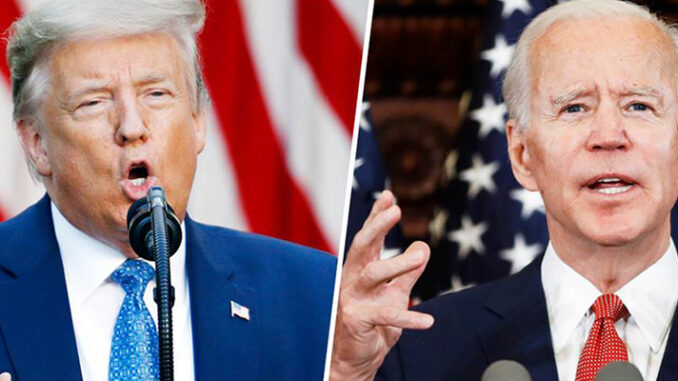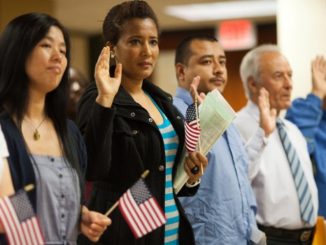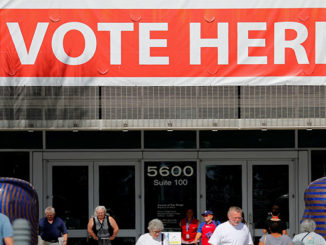
by
When Donald Trump descended a gilded escalator at Trump Tower in New York in 2015, he made the central animus of his presidential campaign immediately clear:
“When Mexico sends its people, they’re not sending their best,” he said. “They’re bringing drugs. They’re bringing crime. They’re rapists. And some, I assume, are good people.”
His rhetoric was broadly rejected as xenophobic fear-mongering, panned as proof that the businessman best known as a reality-TV host was not a serious 2016 candidate.
A sharp whistle to the basest instincts of the American voter was a surefire way to ensure your own irrelevance in a country with rapidly shifting demographics — or so warned the GOP’s “autopsy report” from 2012, which advised the party to champion immigration reform, tolerance and inclusivity, or “continue to shrink to its core constituencies only.”
Yet, almost four years in the White House later, for an infamously inconstant leader, President Trump has been remarkably consistent on immigration. By end-running Congress and largely sidestepping the courts, he has succeeded beyond even the nativist fever dreams of his 2016 run to remake the U.S. immigration system.
Trump’s policy on immigration is, in effect, a negation. Abandoning any pretext of targeting only illegal action or working with Congress — including when Republicans controlled both chambers — through more than 400 executive actions, according to the Migration Policy Institute, his administration has essentially sealed off the U.S. southern border, slashed legal immigration and reduced foreign policy toward Latin America to enforcement.
In some ways, Trump has embraced and expanded several of President Obama’s key initiatives on immigration, including those championed by then-Vice President Joe Biden.
Obama deported more immigrants than any other president, over eight years when migration largely plateaued. His administration conducted widespread family raids, prioritizing Central American parents and children for removal. And when pushing billions in economic aid to the region to help stem an influx in unaccompanied minors arriving at the U.S.-Mexico border — coupled with “Plan Frontera Sur,” a surge of security assistance intended to effectively move the border south to Guatemala — Biden was his point man.
This precedent helped enable Trump officials to leverage a sprawling, dysfunctional post-9/11 security infrastructure toward achieving the president’s jingoistic political agenda.
Under a cloud of polls showing Trump’s base eroding and him lagging behind presumptive Democratic nominee Biden, the president is doubling down in a flurry of last-ditch immigration policy changes on the pretext of the coronavirus to try to reignite his supporters. But as Biden’s primary opponents warned him, it’s no longer enough to not be Trump on immigration.
The former vice president now has to confront his own legacy. If he wins, he will try do what Obama, and others before him, could not: comprehensive immigration reform with a pathway to citizenship for the millions of undocumented immigrants in the United States. But he’ll have to first address the hundreds of complex, interlocking actions Trump has taken, from little-noticed administrative adjustments to sweeping policy changes, in order to ultimately rebuild an already broken and now battered U.S. immigration system.
Still, whether the president or Biden wins in November, the U.S. will be left grappling with Trump’s immigration policy long after he leaves the Oval Office. Here’s where they stand:
President Trump
Deterrence has been the immigration policy of choice for both parties for decades, but Trump and his closest aides — particularly anti-immigration hardliner Stephen Miller — have taken it to unprecedented extremes.One of Trump’s favorite targets has been asylum, which he calls “a hoax.” He suggests that because most pass the first step — a credible fear screening, set by Congress to be a low bar — but ultimately, only about 25% win asylum, that means most claims are fraudulent.
In reality, Trump and his officials have waged war on the asylum system because they are trying to bar primarily Central Americans fleeing countries ravaged by corruption, violence, poverty and climate change, who, once at the border are by the design of U.S. law difficult to kick out.
U.S. law grants migrants the right to seek asylum, regardless of how they enter the United States. The federal statutes center on “non-refoulement” — not sending people back to countries where they’d probably be persecuted, harmed or killed, based on race, religion, nationality, political opinion, or particular social group.
U.S. asylum law, conceived of primarily post-WWII, is clearly outdated. Yet Trump’s policies to end it have been consistently met by court challenges. These tactics have included separating families or making them wait for U.S. immigration court appearances in dangerous Mexican border cities; indefinitely detaining others with no chance of bail or parole despite having broken no laws; and, most recently, in the name of “public health,” rapidly “expelling” nearly every migrant, including unaccompanied minors, with no chance to seek asylum, no coronavirus testing and no way to track what happened to them.
So Trump has gone around the courts and Congress with his executive actions, leaving perhaps the biggest bureaucratic tangle a Biden administration would be left to undo, with an even more backlogged immigration court system and inevitable future spikes in migration.
Trump’s pattern of testing institutions and fundamental assumptions about governance with his immigration policy has played out with mixed results.
On perhaps his most infamous policy — family separation — Trump issued an executive order in 2018 to stop the policy his officials still maintain was not a policy amid worldwide outcry, just before a judge ordered an end to the practice and ultimately, required the government to reunite families. And yet, authorities continue to separate families.
Even after a June Supreme Court ruling rejected the administration’s effort to rescind the popular Obama-era Deferred Action for Childhood Arrivals program, or DACA, Trump is defying the court and attempting to run out the clock, according to legal experts and lawmakers, refusing to accept new applications and limiting renewals.
Although the president has expressed some sympathy for young immigrants and continues to claim that he’ll propose sweeping comprehensive immigration reform — potentially including a pathway to citizenship for certain immigrants — the Miller camp of his administration has always held sway.
Recently, Trump issued memos freezing most new green card applicants and barring most categories of family- and employment-based immigration through after the election, while sparing large swaths of the agricultural and healthcare industries determined to be essential in the coronavirus response. The administration has also implemented new “wealth test” policies to keep out poor migrants, rejecting those who might use, or whose U.S. citizen children might use, public benefits.
Research shows that immigrants strengthen the economy and typically don’t compete with U.S.-born workers for jobs or lower their wages, and many of the affected industries, as well as Trump officials themselves, have advocated for more immigration, not less.
The administration has sought to restrict citizenship, raising fees for naturalizations and slowing processing of hundreds of thousands of potential 2020 voters while at the same time ratcheting up funding dedicated to vetting and rooting out fraud.
One of Trump’s first moves was to issue his “travel ban” targeting travelers from many Muslim-majority countries, citing national security concerns. Though the ban prompted chaos at airports and the White House, the Supreme Court ultimately upheld a third version of it.
He’s gone on to threaten hundreds of thousands more people already in the U.S., including Venezuelans, Salvadorans and Nepalis, by curbing Temporary Protected Status. And refugee admissions are expected to fall below even the ceiling of 18,000 that the administration set for 2020, the lowest level ever under the modern refugee system, though Miller and others have pushed for zero.
These moves harken back to Trump’s comments in the Oval Office in January 2018, when amid a bipartisan standoff over Dreamers, Trump asked: “What do we want Haitians here for? Why do we want all these people from Africa here? Why do we want all these people from shithole countries?”
He added, “We should have people from places like Norway” — a predominantly white country.
Another of Trump’s early executive orders made every immigrant in the country illegally a priority for arrest, in contrast with Obama’s use of “prosecutorial discretion” to prioritize those with criminal records. And yet, beyond the border, immigration arrests and removals by Immigration and Customs Enforcement have fallen under Trump — though the proportion of those deported without criminal records has more than doubled, according to MPI.
Trump’s acting head of ICE — one of many unconfirmed top officials at a Homeland Security Department riddled with vacancies and wracked by ever-shifting political priorities — recently announced his retirement, reportedly in part over frustration from the White House after the agency announced it would scale back enforcement amid the COVID-19 pandemic.
As Trump has gone through half a dozen Homeland Security heads in less than one term, calls to reform the government’s third-largest agency are growing, particularly after the president dispatched heavily armed, unidentified federal officers from DHS to cities across the country undergoing protests against police brutality and racism.
The militarized response in American communities — at the same time as the Trump campaign is fomenting fear in “law and order” ads demonizing Democratic-led cities — follows Trump’s deployment of the military to the border just before the 2018 midterms, where they remain.
He’s also still operating under a “national emergency” declaration, by which he’s redirected billions in federal funding, including from the Pentagon, toward turning his “build the wall” campaign catchphrase into a reality.
And yet, according to Customs and Border Protection’s June status report, only “three miles of new border wall system [have been] constructed in locations where no barriers previously existed.” There are 657 total miles of barrier along the U.S.-Mexico border, according to the report — 654 built by his predecessors, mostly Obama.
Mexico has not, as Trump promised, paid for the wall; but under threat of tariffs, the administration has cajoled Mexico into taking asylum seekers the president doesn’t want in the U.S. and escalating its own enforcement. The administration also leveraged potential visa restrictions and aid cuts to Central America into sign-offs from Guatemala, El Salvador and Honduras to take asylum seekers who are not from their countries.
While those agreements were put on hold amid the pandemic, the Trump administration is pushing the Northern Triangle governments to resume — despite the fact that the U.S. has deported scores of migrants who got the coronavirus in U.S. detention, worsening its spread.
If the aggressive push to tick off the last of Trump’s political priorities on immigration amid a pandemic is any indication, another four years would cement the door shut.
Joe Biden
Joe Biden’s proposed immigration platform aims to undo Trump’s “misguided policies” by taking an opposing position on just about every one of the president’s efforts to curb immigration and limit protections for immigrants, both those who are here legally and illegally. Biden would expand protections for immigrants and restore many of the Obama-era policies overturned by Trump. The former vice president would aim to go further than Obama was able to, working with Congress to establish a pathway to citizenship for the roughly 10.5 million people who are in the U.S. illegally.
The former vice president also supports compromise legislation for farm workers that would potentially offer them a fast track to citizenship as well, based on prior agricultural work history.
Biden, who voted in favor of the Secure Fence Act of 2006, which approved funding for a border wall, has criticized Trump’s “obsession” with the wall.
Biden has said that during his first 100 days in office he would end Trump’s national emergency declaration, which has rerouted billions in federal funds to the border wall, and instead direct resources toward improving security at ports of entry.
The Democrat has sharply criticized Trump’s zero-tolerance policy that separated thousands of families at the border. He’s promised that in his first 100 days he would prioritize family reunifications, reinstate the DACA program and rescind the Trump administration’s travel ban on many Muslim-majority countries.
Biden promises to work with Congress to increase the number of employment-based immigration visas and triple the number of U visas granted to victims of human trafficking and certain other crimes. He’s also vowed to raise the annual refugee admissions to 125,000. In Obama’s last year, admissions were just under 85,000; Miller and others have pushed to reduce them to zero.
Biden’s plan also aims to address the root cause of immigration from Central America.
With families forced to flee violence and near-certain death in their home countries, Biden acknowledged that the “most effective and sustainable way” to decrease migration is by reducing poverty, insecurity and violence through international partnerships. He proposes a four-year, $4-billion regional plan that, in collaboration with leaders in Guatemala, Honduras and El Salvador, would target corruption, invest in civil society organizations on the frontlines and require the home countries to allocate their resources toward concrete reform.
To pay for the Unite States’ investment in the plan, Biden would use funds from the Department of Homeland Security’s budget for the detention of migrants, which has increased under Trump. Biden would also end the use of for-profit detention centers to hold migrants.
The former vice president, according to his proposed immigration policy plan, would also restore protection for domestic violence survivors left unprotected by their governments, which the Trump administration has tried to disqualify as a basis for asylum.
As part of the effort to ease the ballooning backlog of immigration cases, many of them asylum seekers, Biden said he would also increase the number of immigration judges, court staff and interpreters.
In July, the Biden-Sanders Unity Task Forces, a combination of supporters of Biden and his former primary rival Vermont Sen. Bernie Sanders, offered platform recommendations that included protecting the parents of Dreamers under the Deferred Action for Parents of Americans, or DAPA.
Biden has offered few details on a route toward citizenship for those family members, which the task forces recommend should be reinstated. The campaign said he would use every legal option to protect Dreamers and their families.
Immigration activists have criticized the former vice president over Obama administration policies. In February, Biden expressed remorse for the millions of deportations the Obama administration carried out, calling the policies a “big mistake.”
Obama’s immediate Republican and Democratic predecessors apprehended millions more people at the border, but often returned the primarily single adult Mexican migrants quickly, with no formal process.
The Biden-Sanders task forces stopped short of endorsing calls to abolish Immigration and Customs Enforcement. Biden instead calls for increased training and oversight of the interior enforcement agencyand Customs and Border Protection, which oversees the Border Patrol. He has said that he would protect sensitive locations such as hospitals, schools and places of worship from enforcement actions and end workplace raids, which have increased under Trump.
It’s likely that as the election nears, Trump will attack Biden over his healthcare plan and its coverage for immigrants in the country illegally. The president has accused the Unity Task Forces of wanting taxpayer subsidized “government healthcare for all illegal aliens.”
Biden has said healthcare coverage should be available for everyone, no matter their legal status. His campaign said he supports allowing immigrants who are in the U.S. illegally to buy unsubsidized coverage.
The Biden-Sanders task forces recommend extending Affordable Care Act coverageto DACA recipients and working with Congress to cut the wait time for immigrants with legal status to become eligible for some government programs.
The former vice president has spoken about how Trump’s policies and rhetoric have damaged immigrants.
“Donald Trump and his administration have pursued an all-out assault … on Latino communities from the moment he came down that golden escalator,” Biden said, referring to Trump’s xenophobic comments when he announced his candidacy in 2015. He spoke Aug. 6 at a virtual conference hosted by an organization of Latino leaders.
Biden tied Trump’s fear-mongering about immigrants crossing the southern border to the 2019 mass shooting in El Paso, where Latinos were targeted by a suspect whose white supremacist screed posted online blamed the attack on a “Hispanic invasion of Texas.”
“The stakes of Trump’s irresponsible policies of division and hate that he promotes is real,” Biden said.
Molly O’Toole is an immigration and security reporter based in the Los Angeles Times’ Washington, D.C., bureau. @mollymotoole
Melissa Gomez is a reporter covering the 2020 presidential campaign. She joined the Los Angeles Times in 2018 after graduating from the University of Florida. She is a proud native Floridian. @MelissaGomez004



